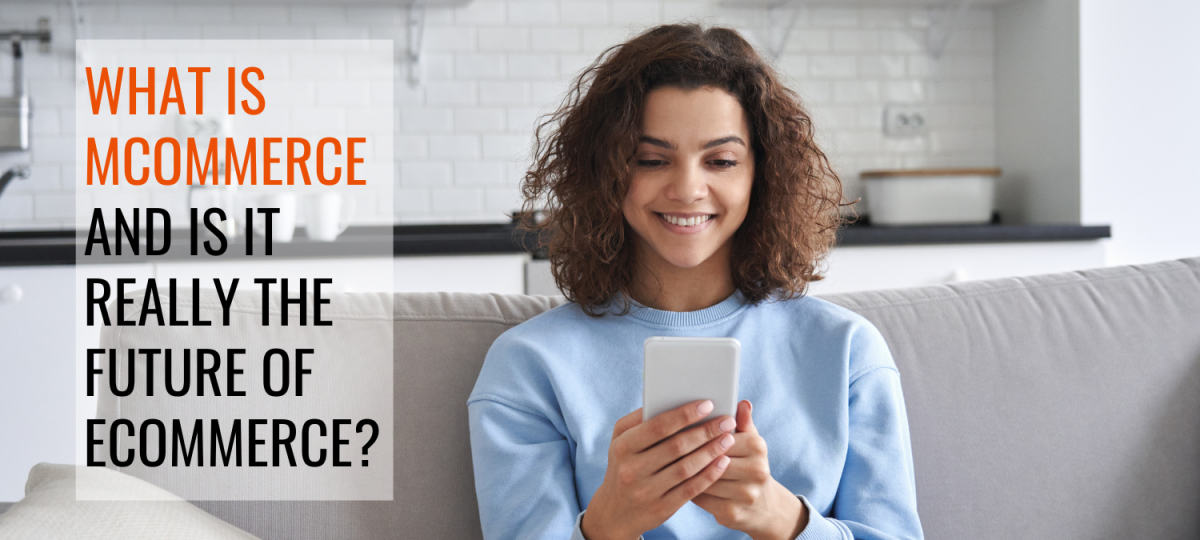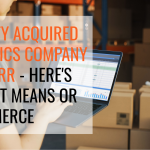Ecommerce has exploded in popularity in the last few years and is expected to account for more than $6.5 trillion in sales by 2023. However, another term you may have also come across is mcommerce, or mobile commerce, which is growing rapidly.
Simply put, mcommerce is the buying and selling of goods and services strictly via mobile devices. And it’s a method that we’re increasingly using.
With Americans now spending more than four hours a day on average on their smartphones, it’s not surprising that more than 79% of them have made at least one purchase using their mobile device – and that’s just getting started.
Here are some more mobile commerce statistics:
- In 2021, mcommerce sales made up more than 50% of all ecommerce sales.
- Mcommerce sales reached $3.56 trillion in 2022, making for a 22.3% growth over the $2.91 trillion registered in 2021.
- Mobile payments are set to grow by 24.5% by 2026.
- Nearly 70% of consumers have downloaded a retail app.
- 54% of consumers use social media apps to research new products and services.
There’s no doubt about it: mcommerce is growing rapidly as more and more people begin to conduct their online shopping on smartphones. But you might be thinking, where does that leave ecommerce?
Before we get into the nitty-gritty, let’s first take a further look at what mobile commerce exactly is and how it differentiates from ecommerce.
What is Mcommerce?
Techjury’s Christo Petrov states, “m-commerce or mobile commerce is the buying and selling of goods and services through wireless handheld devices such as smartphones and PDAs.”
Some experts define mcommerce as a subset of ecommerce, however, others refer to it as the next generation of ecommerce entirely. This is because, really, mobile commerce is so much more than just the buying and selling of goods.
Here are the three primary areas that mcommerce covers:
- Mobile Shopping: Through dedicated shopping apps, social media apps, and marketplaces, mcommerce includes the buying of things through ecommerce sites via a mobile device.
- Mobile Banking: Many banks now offer mobile banking, where their customers have an option to complete all their monetary needs through an app, including making deposits, initiating money transfers, and paying bills.
- Mobile Payments: Mcommerce also covers mobile applications often referred to as digital wallets, that work as debit or credit cards through a smartphone. Some examples of these are Apple Pay, Android Pay, and Google Pay.
This is what sets mcommerce aside from ecommerce; while ecommerce also allows for the purchasing and selling of goods and services over the internet, mcommerce takes it that step further as customers can do all of that at the same time while on the go.
For example, in general, ecommerce activities are performed on desktop computers or laptops, whereas mcommerce is only carried out on handheld devices, such as smartphones and tablets, meaning people engage in any ecommerce activity no matter where they are.
Another key difference between the two is that in ecommerce, the use of the internet is mandatory. However, some mobile commerce activities, such as mobile payments, can be carried out without the internet.
And finally, ecommerce location tracking abilities are limited, due to most of its activities being carried out on non-portable devices. Whereas mcommerce can be tracked no matter where the consumer is due to handheld devices being portable.
The Advantages and Disadvantages of Mcommerce
Now that we’ve determined what distinguishes mcommerce from ecommerce, let’s look at its advantages and disadvantages:
Advantages of Mcommerce
- Worldwide Reach
One of the greatest benefits of mobile commerce is that it allows brands to enter markets that 20 years ago would have been near impossible. With people logging into social media apps every day from all around the world, online businesses can reach customers from almost anywhere.
- Convenience
Mcommerce makes shopping faster and simpler for shoppers, offering 24-hour sales, easy returns, and fast delivery, all from their hands. There’s no need for someone to head into a physical store now if they don’t want to. They can effortlessly engage in online shopping using their smartphone from wherever they are, whether that be in a café, at the office, or from home.
- Personalized Marketing
Mcommerce businesses can easily personalize their audience’s experiences via mobile apps, making customers feel appreciated and valued, while increasing customer loyalty. Using gathered customer data, brands can also push out personalized adverts, notifications, and more, to hook a buyer in.
- Assisting With Traditional Sales
One of the more incredible facts about mcommerce is that 84% of consumers today use some type of shopping app on their mobile device while shopping inside a store. For example, when someone is in a physical store and finds an item that interests them, they may then go search for that product on the brand’s social media to see how and who is using it, pushing them further down the road to purchase.
- Location Tracking
You can provide value to your customers with location tracking, sending them the right information at the right time, and the right place. As an example, if a customer has subscribed to your brand, depending on what your brand offers, you can use their location data to send them location-based push notifications encouraging them to take an action.
Disadvantages of Mcommerce
- Security and Fraud Risks
The biggest drawback of mcommerce is the high number of frauds and uncertainties that can result in the loss of personal data, which many people are worried about. As a result, not everyone is willing to complete online transactions from a mobile device out of fear of being hacked or having their data stolen.
- Mcommerce Demands Technology Access
Another downside to mobile commerce is the requirement of technological access. You won’t be able to make use of its enhanced features unless you have the internet to operate your smart device and place your order online, which not everyone does.
- Inability to Access Rural Shoppers
Taking technology access one step further, there is still a scarcity of mobile phones and internet connections in rural regions in particular. As a result, many individuals are still unaware of mobile commerce, and perhaps ecommerce entirely.
Get our GN - What is Mcommerce and Is It Really the Future of Ecommerce? delivered right to your inbox.
Is Mcommerce the Future of Ecommerce?
As we’ve seen, there are plenty of benefits to mcommerce, especially in today’s ever-growing digital environment. With so many people owning and actively using smartphones, it’s logical that businesses are starting to advertise, market, engage, and sell with them.
But is mcommerce really the future of all ecommerce? Traditional ecommerce most certainly still has its place. However, not everyone is comfortable with making purchases directly from their smartphones and may instead opt to shop using a traditional PC or laptop.
However, an argument can be made that further integrated use of both ecommerce and mcommerce techniques are where many brands are headed. For example, the combined use of ecommerce and mcommerce allows brands to gather more data and information on their customers, which can then be used to inform their marketing and drive greater sales.
While ecommerce is most certainly here to stay, the continued use and rise of mobile devices will only continue to drive mcommerce in the years to come.
Four Mcommerce Trends to Guide Your Strategy
With so many people on mobile devices now, millions of online stores are starting to take advantage of mobile-driven purchasing potential, with many trends emerging already.
Here are four mcommerce trends to consider when crafting your brand’s digital strategies:
Optimizing Your Website for Mobile
This one may seem obvious, but ensuring your website is mobile-friendly is crucial. So much so that Google now penalizes non-mobile-friendly sites.
Taking this one step further, you could create an mcommerce shopping app for your online store, allowing customers the option to buy or access services directly from the app. Mobile apps also increase the marketing opportunities available to your brand, such as by sending out push notifications and being a place to create and manage loyalty programs.
Personalization
Just like ecommerce, the best way to win over your audience in mcommerce is by personalizing their experience. In fact, 80% of customers prefer buying from a brand that has personalized content to suit them. So, when engaging with shoppers on mobile apps, such as social media, ensure your marketing is data-driven, which will help you reach the right audience, with the right content, at the right time.
Social Commerce
Originally, social media was used by brands to generate brand awareness and drive leads. However, today, social platforms are commonplace for brands to not only market to their audience but sell to them too. Many social channels, such as Instagram and TikTok, now offer brands the opportunity to sell directly to consumers without having to leave the app.
Crypto Payments
Cryptocurrency has taken off massively in the last year, and is expected to be worth $1.40 billion by 2023. As a result, many people are now seeking to pay online using their crypto wallets in place of traditional payment options. Therefore, your online business may soon consider adding the payment option to your mcommerce shopping apps, or online store, to meet these demands.
Mcommerce FAQs
What is mcommerce?
Mcommerce, or mobile commerce, is the buying and selling of products and services strictly from handheld devices such as smartphones or tablets.
Is mcommerce a subcategory of ecommerce?
It depends on how you look at it. Many experts view it in this way, as ecommerce is the buying and selling of goods and services via the internet, which mcommerce also is. However, many in the industry see mcommerce as its own thing entirely, with some predicting it will take over ecommerce entirely.
What are the main differences between mcommerce and ecommerce?
The main difference between mcommerce and ecommerce is how it is used. For example, mcommerce is conducted only through the use of handheld devices, whereas ecommerce is generally carried out on non-portable devices such as desktop computers.
What are some examples of mcommerce?
Mobile banking, mobile shopping, and mobile payments are the three main areas of ecommerce. However, it can also include ticketing, e-documents, mobile wallets, location-premised services, and more.
The Next Step: Getting Started With Social Commerce
For ecommerce brands wanting to move their business to mobile, social commerce is one of the easiest and more beneficial ways to do so. Almost all of the major social media platforms now offer mcommerce options for business, making right now a great time to sign up and drive sales through mobile devices.
Here’s how to get started:
Step One: Determine what social commerce platform is best for you, such as Instagram, Facebook, or TikTok. The main driver behind your selection should be the platform where your target audience spends most of their time.
Step Two: Once you’ve selected the platform, it’s time to start building your online shop. For example, if you’ve chosen to use Instagram’s Shop tool, you’ll need to head into commerce manager and start building your shopping catalog. This guide will provide you with more information for selling on Instagram.
Step Three: Now that you’ve set up your social commerce store, whether it’s on Instagram, TikTok, Facebook, or something else, it’s time to start promoting your products. You can do this by integrating it with your planned social content, by simply adding product tags and links to buy, for example.
Pro Tip: A marketing technique that many brands use to advertise their products on social media is influencer marketing. As a bonus, many social commerce platforms now allow influencers to add the likes of product tags into posts they are sponsoring, which link back to your online shop, giving you all the more reason to give them a go.
If you need help finding marketing strategies to scale your business, reach out today for a free 20-minute consultation. Let’s look at solutions that will take your ecommerce business to the next level.
Get our GN - What is Mcommerce and Is It Really the Future of Ecommerce? delivered right to your inbox.






